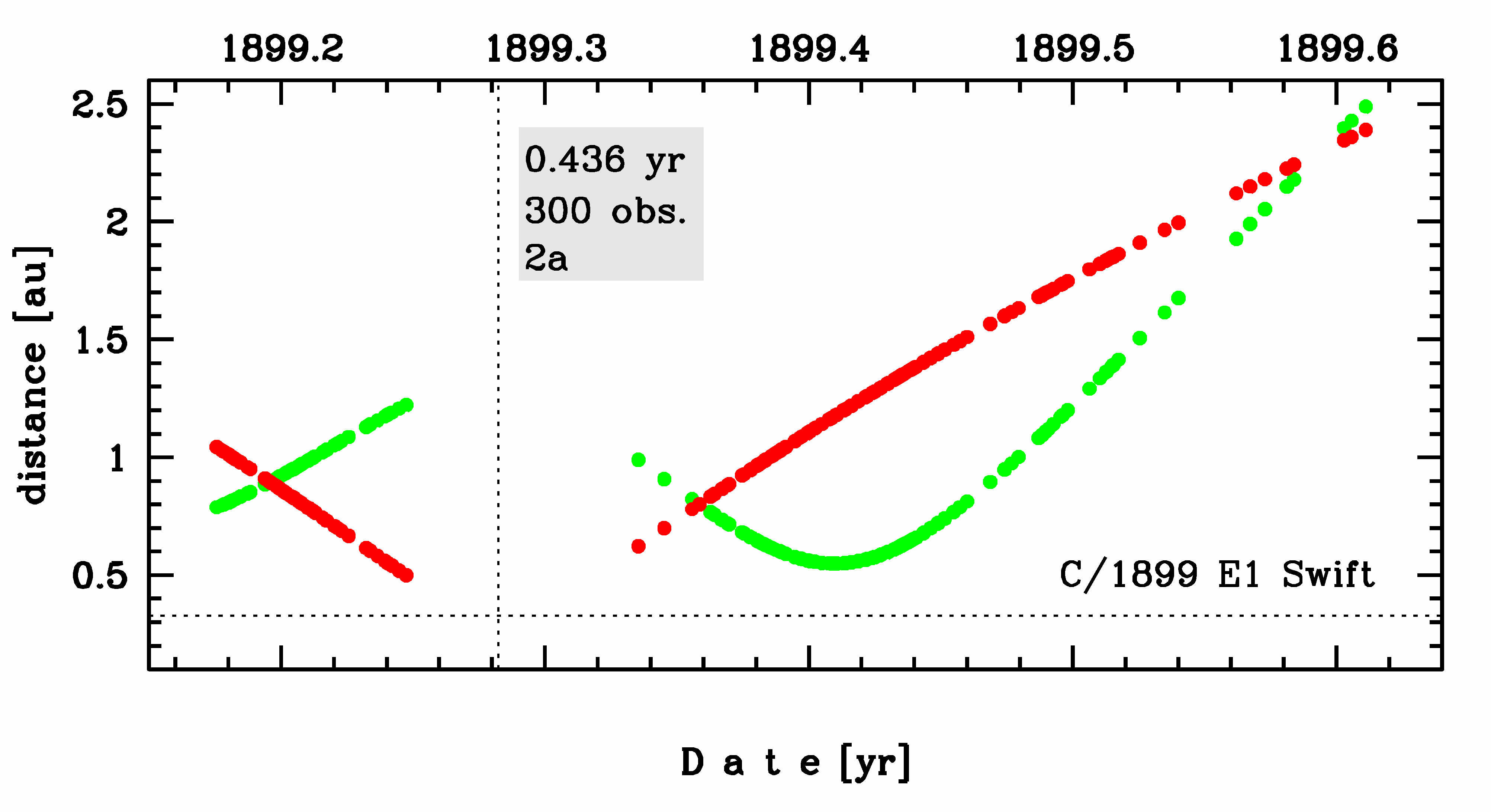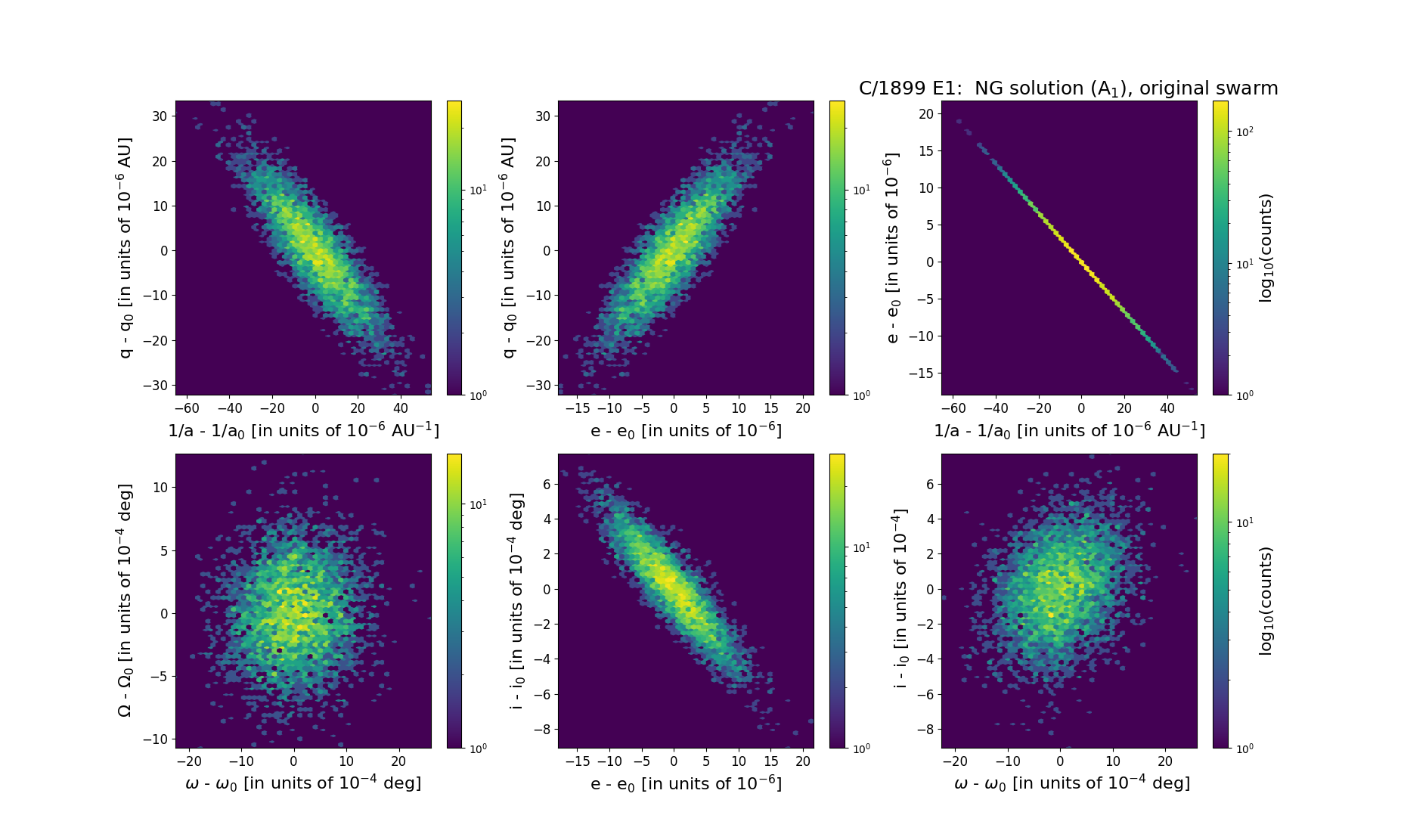C/1899 E1 Swift
more info
C/1899 E1 was discovered on 4 March 1899 by Lewis A. Swift (Lowe Observatory, Echo Mountain, California), that is more than a month before its perihelion passage, and it was last seen on12 August 1899 [Kronk, Cometography: Volume 2].
This comet made its closest approach to the Earth on 21 February 1899 (0.711 au), that is about 2 weeks before its discovery.
Solutions given here are based on data spanning over 0.435 yr in a range of heliocentric distances from 1.04 au through perihelion (0.327 au) to 2.39 au.
In this comet the second nucleus were observed starting from mid-May 1899; therefore, due to nucleus splitting NG solutions given here should be treated as approximate.
Original value of 1/a is negative for all solutions presented here; however, within its uncertainty of 1 sigma this comet can came from the Oort Cloud according to preferred solution (non-gravitational solutions with radial NG component).
This comet suffers very large planetary perturbations during its passage through the planetary system; these perturbations lead to escape this comet from the planetary zone on hyperbolic orbit (see future barycentric orbits).
See also Boehnhardt 2004 and Królikowska 2020.
This comet made its closest approach to the Earth on 21 February 1899 (0.711 au), that is about 2 weeks before its discovery.
Solutions given here are based on data spanning over 0.435 yr in a range of heliocentric distances from 1.04 au through perihelion (0.327 au) to 2.39 au.
In this comet the second nucleus were observed starting from mid-May 1899; therefore, due to nucleus splitting NG solutions given here should be treated as approximate.
Original value of 1/a is negative for all solutions presented here; however, within its uncertainty of 1 sigma this comet can came from the Oort Cloud according to preferred solution (non-gravitational solutions with radial NG component).
This comet suffers very large planetary perturbations during its passage through the planetary system; these perturbations lead to escape this comet from the planetary zone on hyperbolic orbit (see future barycentric orbits).
See also Boehnhardt 2004 and Królikowska 2020.
| solution description | ||
|---|---|---|
| number of observations | 300 | |
| data interval | 1899 03 05 – 1899 08 11 | |
| data type | perihelion within the observation arc (FULL) | |
| data arc selection | entire data set (STD) | |
| range of heliocentric distances | 1.04 au – 0.33 au (perihelion) – 2.39 au | |
| type of model of motion | NS - non-gravitational orbits for standard g(r) | |
| data weighting | YES | |
| number of residuals | 563 | |
| RMS [arcseconds] | 2.73 | |
| orbit quality class | 1b | |
| orbital elements (barycentric ecliptic J2000) | ||
|---|---|---|
| Epoch | 1602 07 02 | |
| perihelion date | 1899 04 13.78639348 | ± 0.00366849 |
| perihelion distance [au] | 0.33207082 | ± 0.00000957 |
| eccentricity | 1.00000516 | ± 0.00000492 |
| argument of perihelion [°] | 8.371776 | ± 0.000608 |
| ascending node [°] | 26.206128 | ± 0.000322 |
| inclination [°] | 146.084952 | ± 0.000221 |
| reciprocal semi-major axis [10-6 au-1] | -15.53 | ± 14.83 |
| file containing 5001 VCs swarm |
|---|
| 1899e1m1.bmi |

